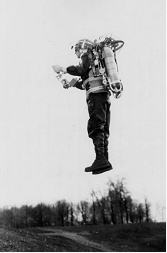
Personal Jetpacks
Since the Wright brothers' first 12-second flight in 1903 we've seen impressive development of flying machines, from the helicopter to the Space Shuttle. However, a small, personal jetpack has proved both enticing and elusive.
 Bell Rocket BeltCourtesy of US Army Transport Museum
Bell Rocket BeltCourtesy of US Army Transport Museum
The first manifestation of a working jetpack was the Bell Rocket Belt, flown for the first time in 1961. The Rocket Belt used 2 vectored rocket nozzles to provide lift and control, and was fueled by hydrogen-peroxide and nitrogen, which were contained within a backpack worn by a pilot. While matching the notional concept and size of a jetpack, the Rocket Belt did not so much fly as provide enough thrust for long hops of less than 30 seconds before requiring refueling. Arguably the most noteworthy appearance of a Rocket Belt was as an escape vehicle for James Bond in the 1965 movie Thunderball.
Advances in materials, analysis methods (e.g., Computational Fluid Dynamics) and propulsion technology have enabled winged personal jetpacks to take flight. Instead of using rockets to counter gravity, these jetpacks use lightweight carbon fiber wings to create lift, powered by small turbojet engines. They require release from a drop airplane as they don't have enough thrust and lift to take off from the ground.
Yves Rossy is a pioneer of winged jetpacks which are essentially flying wings. His homemade jetpack consists of a folding (to fit inside the drop airplane) 3m wing, 2 small turbojets engines and a parachute. Once released from the drop airplane, Rossy extends his wings and ignites his jet engines to fly for up to 6.5 minutes. After completing his powered flight he releases his parachute and floats to Earth.
Another winged jetpack concept design is under development by ESG for military paratroopers. The proposed GRYPHON is a delta wing with aerodynamic controls and is powered by twin turbojets. This time James Bond was ahead of reality and used a glider called a Switchblade of similar design to infiltrate an enemy base in the 2002 movie Die Another Day.
So far we've discussed rocket and winged jetpacks, so that leaves helicopter based jetpacks if we were to mimic the full spectrum of full-size powered aircraft. Sure enough, Trek Aerospace is developing a twin ducted fan "personal air vehicle" – you can't really call it a jetpack as it has no jet; instead it is powered by a rotary engine. Ducted fan propulsion systems are essentially helicopter blades rotating in a close-fitting nacelle for improved aerodynamic efficiency. Their Springtail Exoskeleton Flying Vehicle (EFV-4A) allows vertical takeoff and landing, and flew for the first time in 2003.
It seems that James Bond is good indicator of personal jetpack progress, so all we have to do to see the next stage of their development is lookout for his next movie. If only it were that simple.
- Richard Smith's blog
- Login to post comments
Select Language
Recent blog posts
- CFD Simulates Distant Past
- Background on the Caedium v6.0 Release
- Long-Necked Dinosaurs Succumb To CFD
- CFD Provides Insight Into Mystery Fossils
- Wind Turbine Design According to Insects
- Runners Discover Drafting
- Wind Tunnel and CFD Reveal Best Cycling Tuck
- Active Aerodynamics on the Lamborghini Huracán Performante
- Fluidic Logic
- Stonehenge Vortex Revealed as April Fools' Day Distortion Field


Comments
Rocket Belt Market Heats Up
Add another manufacturer to the rocket belt (or jet pack) market - that makes it 3. Read about the latest entrant Thunderbolt Aerosystems and its projected sub US$100,000 ThunderPack in The Inside Story of When Jet Packs Really Are Coming.
First Public Display of Jet-Powered Wing
Yves Rossy (self appointed 'Fusion Man') recently (May 15, 2008) made the first public display of his latest jet-powered wing. The 5 minute flight in the Swiss Alps reaching speeds of 186 mph, was the culmination of 5 years development and training. Rossy's latest wing design uses 4 micro-jet engines attached to an 8 foot foldable wing. Later in the year Rossy intends to use the jet-powered wing to cross the English Channel (22 miles).
GEN H-4 Personal Helicopter
The GEN H-4 isn't technically a jetpack (more of a personal helicopter), but it fulfills the same role. To find out more try "Personal Helicopter Available Now."
Fan-Pack
Glenn Martin, an inventor from New Zealand, joins the ever expanding list of hobbyists willing to develop and test their own personal jetpack. Technically you might call Martin's vehicle a fan-pack as it incorporates twin ducted-fans powered by a conventional gas engine. Find out more at "The Jetpack: From Comics to a Liftoff in the Yard."
Jet-Powered Wing Crosses English Channel
Yves Rossy made good on his promise to cross the English Channel using his jet-powered wing on September 26, 2008.